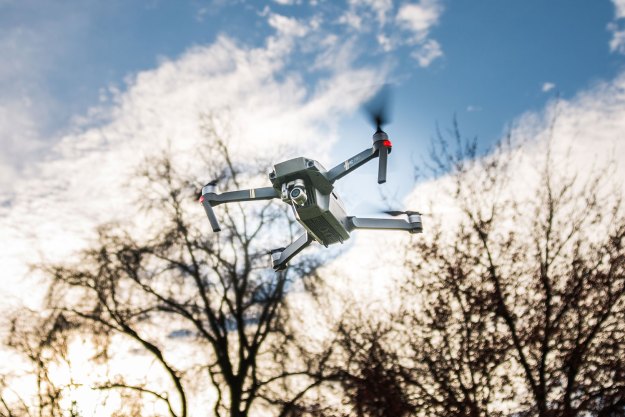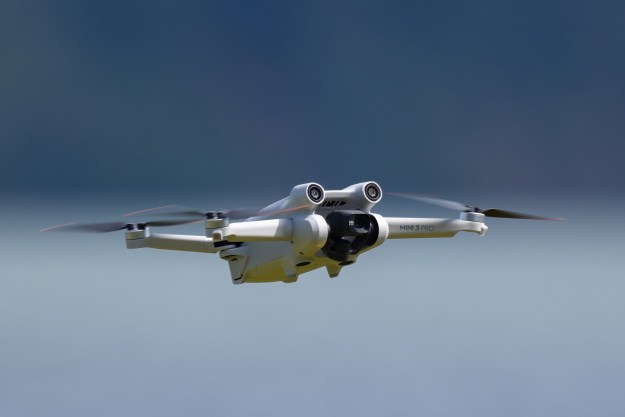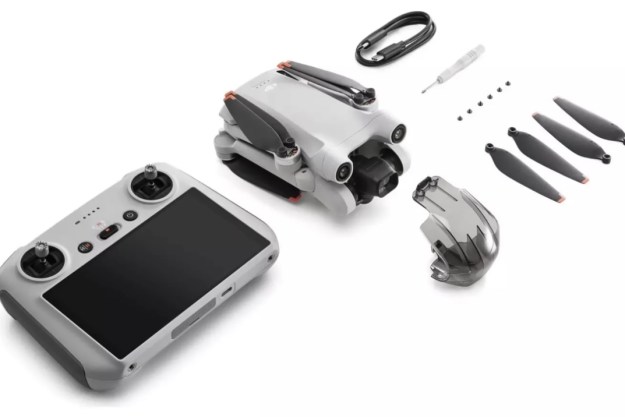
- Super portable design
- Solid construction
- Outrageously long range
- Gimbaled 4K camera
- Reasonably priced
- Fragile gimbal assembly
Portability is all the rage in drones right now – pilots want quadcopters they can pack up and take anywhere. Unfortunately, a compact form factor usually translates to fewer features and abilities. But with DJI’s Mavic Pro, that couldn’t be further from the truth. In addition to being one of the most portable drones we’ve ever seen, the Mavic also happens to be one of the most feature-packed drones on the market.
But do portability and capability really coexist in the real world? We took it out for a solid week of hardcore flight tests to find out.
Features and specs
Without a doubt, the most standout feature of the Mavic is its portability. DJI went back to the drawing board with this drone, and it shows. Instead of a space-hogging fixed-arm hull, the Mavic features a set of folding arms and props that, thanks to their clever configuration, allow the drone to fold down into a neat little package that’s roughly the size of a standard brick (but not quite as heavy). This, along with the super compact controller, make the Mavic one of hte most portable drones we’ve ever encountered.
Up front, it’s also equipped with a 4K camera and super compact 3-axis gimbal. This allows the device to capture super stabilized video without the resolution cutbacks required for digital stabilization. Plus, behind the camera, the drone also has DJI’s ActiveTrack and Optical Flow software, which allow it to track objects and sense obstacles (respectively) using nothing but the camera and image analysis algorithms.
Flight and range specs are also pretty impressive. DJI equipped the Mavic with an all-new video transmission system called OcuSync, which stretches the Mavic’s max range to over 4 miles and also boosts its resistance to interference. At shorter ranges, this tech can even stream footage to you at 1080p resolution, allow photo and video downloads at 40Mb/s – which is absolutely nuts.
To round out the package, the Mavic Pro also sports all the same Intelligent Flight Modes that DJI’s Phantom 4 has — plus two new ones. In addition to the standard Follow mode, Point of Interest, Waypoints, and Course Lock, the Mavic also has DJI’s new Terrain Follow and Gesture modes. It’s absolutely stuffed with features.
Build quality and design
Build quality is off the charts. The Mavic Pro is a sturdy little beast with one of the toughest hulls we’ve ever encountered. We crashed it a handful of times and it didn’t even seem fazed. Sure, it’ll complain and tell you “Ouch, you crashed me!” in a series of annoying beeps — but after a quick reset it’ll forget the whole thing ever happened and get right back to flying like a champ. We wouldn’t trust it to survive a big plummet onto a hard surface, but 30 feet onto a patch of grass? No problem.
When it comes to portable drones, the Mavic Pro has no equal — at least not yet.
Same goes for design. DJI deserves a Red Dot Award for this one — it’s nothing short of brilliant. I mean, we’ve seen folding drones before, but this one takes it to a whole new level. Thanks to a very clever hinge system, the arms fold up into a neat little package just smaller than the dimensions of your average brick, which makes it a breeze to stuff in your backpack or messenger bag and lug along on your adventures. It might even fit in a purse.
Another design element that we’re totally in love with is the portable controller. It’s not a measly little smartphone app that forces you to use virtual joysticks, and it’s also not a gigantic ground station that takes up half your backpack — it’s a thoughtfully designed hybrid that gives you the best of both worlds. When it’s all folded up, it’s roughly the size of a walkie talkie — but flip out the antennas and pop in your smartphone, and suddenly it’s a full-fledged controller with tons of telemetry data, an intuitive layout, and fantastic range.
The only real flaw we could find on the machine was its 3-axis gimbal assembly. It’s impressively small and compact, but it’s also held in place with four small rubber bands that seem to be a bit fragile. If one of these bands snaps (which happened to our review unit while it was in the previous user’s possession), the camera will have trouble stabilizing itself, which ultimately means you’ll end up with shaky, “Jello-effect” video footage. That’s really the only design flaw we could find though — everything else on the Mavic is well-built and designed to last.
Battery life and recharge time
Despite its compact form factor, the Mavic Pro boasts impressive battery life, and actually has one of the longest flight times we’ve ever seen in a quadcopter. It’s a bit of an oddity though — the rotor system is optimized for forward flight, so the drone can actually stay aloft longer in motion than hovering. DJI claims it can maintain a hover for 24 minutes, but thanks to its aerodynamic design, it can allegedly stay airborne for 27 minutes if you “fly at the optimum speed for energy consumption.”
To put these claims to the test, we ran Mavic through our usual series of endurance tests. First up was a straight-up hover test, where we let the drone hover until it drains the battery and automatically lands itself. Our hover test lasted for exactly 23 minutes and 19 seconds — which isn’t very far off from DJI’s claimed 24 minutes.
Next, to get a sense of how long it’ll last during normal flight, we recorded the flight times from every other flight test we conducted and averaged them out. Over the course of 14 different flights that went from 100 percent battery to emergency low-battery automatic landing, the Mavic averaged a flight time of 25 minutes and 6 seconds. That’s not quite as long as DJI’s claimed 27 — but it’s worth mentioning that we did log a few flights that broke the 26 minute barrier, so we can confirm that flying the Mavic around does indeed boost your flight times — which is pretty cool.
As for recharge times, a mostly-drained battery (around 10 percent remaining) will take about an hour to recharge. A fully drained battery (which isn’t normal, since the drone will auto-land before it reaches that point) takes roughly an hour and 15 minutes to juice back up to 100 percent. So generally speaking, you should expect a little over an hour for each recharge session — which honestly isn’t too bad for a battery that provides 25 minutes of flight time. Still, you’d be wise to pick up a spare if you plan on doing a lot of flying.
Flight performance, autonomy, and range
DJI has outdone itself with this drone. In terms of raw flight performance, the Mavic Pro is easily one of the best quads we’ve ever flown. Technically the motors aren’t quite as powerful as the ones you’ll find in the Phantom 4, but somehow the Mavic still manages to match — or in many cases even surpass — its big brother in a number of different respects.
The first of these are speed and agility. On paper, the Mavic tops out at 40 miles per hour — but our flight logs showed that we actually clocked speeds as high as 51 miles per hour under certain conditions. On a moderately breezy day, it cleared our 100-meter sprint test in 5.3 seconds, which suggests a top speed of about 42 miles per hour. Of course, your top speed will vary depending on the conditions you’re flying in, but as far as we can tell, the Mavic is every bit as quick and nimble as the Phantom 4 — if not more so.
The Mavic has all the same flight modes as DJI’s top-of-the-line Phantom, plus a couple extra. You can set the Mavic to orbit a point in space with Point of Interest Mode; repeat flights along a preset path with Waypoints; follow your movements via Follow Me mode, or even adjust the way it responds to joystick control with Course Lock and Home Lock. These modes are more or less the same in the Mavic as they are in the Phantom 4 — but Mavic has a few new tricks up its sleeve as well: Terrain Follow and Gesture modes.
In Terrain Follow, the drone uses its Downward Vision System to maintain a certain distance from the ground, which is fantastic for filming over terrain that varies in elevation. Gesture mode, on the other hand, allows you to set up and snap a selfie by doing nothing more than standing in front of the camera, waving your arms a bit, and then making a “picture frame” shape with your fingers. Basically, this makes it possible to take drone selfies without having your controller in the picture, which is pretty neat.
One of the Mavic’s standout features is definitely its range. It’s equipped with DJI’s new OcuSync video transmission technology, which stretches the drone’s maximum range and provides a live HD video feed from the camera from up to 4.3 miles away. The thing is, those numbers aren’t necessarily an accurate reflection of the distances you’ll be able to achieve in real-world conditions.
In our longest flight test, we took it out to 11,000 feet (roughly two miles) before our feed stuttered, anxiety got the best of us, and we turned back. We didn’t push the Mavic to the absolute limit, but there are videos online of people taking it out over 17,000 feet before it loses signal and automatically returns to home — so we’re pretty sure that in any case, the Mavic’s range will be enough to satisfy even the most demanding users.
Camera, accessories, and upgradability
The camera on the Mavic is pretty impressive. Despite being considerably smaller than the camera on the Phantom 4, it basically has the exact same specs. It shoots in cinematic 4K, snaps 12.7 megapixel stills, and also supports features like burst shooting and exposure bracketing. It even has a super-compact 3-axis gimbal to keep the camera stable while you fly — a feature that’s notably absent in other portable drones like the Yuneec Breeze and Hover Camera Passport. The only real difference between the Mavic’s camera and the Phantom’s is field of view. At 79 degrees, Mavic’s FOV is slightly narrower than the Phantom 4’s, which is 94 degrees.
The camera is arguably just as important as the software behind it. Much like its big bro, the Mavic sports DJI’s object tracking technology (ActiveTrack), as well as its Optical Flow system, which uses image recognition to spot obstacles and track the drone’s position while flying indoors. As we mentioned before, it’s also equipped with gesture recognition software and adjustable focusing abilities — two features that the Phantom 4 doesn’t have.
As for accessories and upgrades, DJI doesn’t currently offer a particularly wide selection for the Mavic — but that will likely change in the coming months. The company recently unveiled its own FPV goggles, which will be compatible with the Mavic Pro when they’re released. Aside from that, all you can get right now is replacement parts, a carrying case, and a special hub that lets you charge up to four batteries at once.
Our Take
After flying it nonstop for a week, we’re convinced that the DJI Mavic Pro is one of the best drones you can get for $1,000. We wouldn’t even bother getting a Phantom 4 right now. In addition to being cheaper and faster, the Mavic also has more flight modes, a longer range, and a super portable design. So at the end of the day, it’s just more bang for your buck.
Are there better options available?
When it comes to portable drones, the Mavic Pro is definitely one of the best options on the market right now — but depending on what you’re looking for in a drone, there might be a better choice for you. DJI’s newly-released Mavic Air drone is smaller, lighter, and boasts superior obstacle avoidance. It’s also $200 cheaper.
As such, you should only go with the Mavic Pro if your main concerns are battery life and camera performance. The Pro outlasts the Mavic Air when it comes to airtime on a single charge, and its camera also performs slightly better in low light conditions. Check out our detailed comparison to get a fuller picture of the differences.
Other portable drones, like the Yuneec Breeze and Hover Camera Passport, offer similar levels of portability, and are also considerably cheaper than the Mavic ($500 and $600 respectively) — but they’re nowhere near as capable.
If you don’t care so much about portability, Yuneec’s Typhoon H is also a worthy contender. It boasts many of the same features, and has a 4K camera that swivels in 360 degrees. This, along with dual-pilot capabilities, would arguably make the Typhoon H a better choice for amateur filmmakers — but only if you don’t mind lugging your drone around in a giant backpack.
How long will it last?
Probably a few years or more. DJI constantly rolls out updates to its products, and we have no reason to think the Mavic Pro will be any different. Firmware updates come through on a regular basis, and DJI already has a suite of upgrades, attachments, and accessories in the works. So, assuming you don’t destroy it, the Mavic Pro should last you for quite some time.
Should you buy it?
Absolutely. Regardless of what you’re looking for in a drone, the Mavic Pro is a fantastic choice. We’ve rounded up the best Black Friday drone deals you can get, don’t forget to go through them.
Editors' Recommendations
- The 3 best (reputable) DJI Drone alternatives in 2024
- DJI’s new Inspire 3 is an 8K drone for moviemakers
- Mavic 3 design change reduces the drone’s price
- How to watch DJI unveil an all-new drone today
- Watch this Mavic 3 drone soar above the world’s highest mountain












